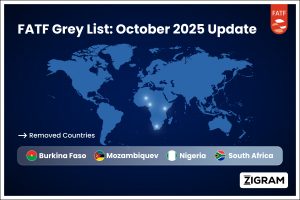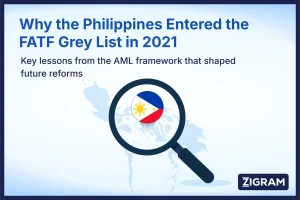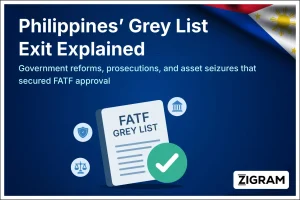Trade-based money laundering (TBML) strategically leverages international trade to mask illicit funds. Criminals exploit intricate supply chains, falsified invoices, shipping documents, and unregulated trade finance channels to facilitate money movement. Recent findings from the Financial Action Task Force (FATF) make it clear that organized crime and sanctions-evasion networks are actively exploiting established TBML tactics, including over-invoicing, under-invoicing, and phantom shipments.
Research unequivocally shows that 63% of TBML cases involve deliberate mispricing of trade values. These techniques enable money launderers to transfer significant value across borders under the guise of legitimate trade. They often declare exports at drastically inflated or deflated values or issue invoices for non-existent shipments. Notably, the scale and sophistication of these schemes are on the rise in Asia and the Middle East, especially within major trading hubs such as the UAE, Singapore, and Hong Kong.
Enforcement agencies are detecting a growing number of TBML incidents. For instance, UAE authorities reported over 600 credible TBML cases in 2022–23, revealing that forged invoices and bills of lading were used in roughly 41% of these instances. Similarly, customs officials in Pakistan and Hong Kong have uncovered multi-million-dollar schemes exploiting inflated or fictitious trade values.
This article decisively examines the mechanisms behind shadow exports and over-invoicing. It underscores the manipulation of shipping, customs, and banking systems, while surveying recent high-profile cases from Asia and the Middle East. Furthermore, we review FATF findings, identify critical red flags, and address emerging trends—such as the use of free zones, dual-use goods, and trade finance—to empower compliance officers to effectively identify and combat TBML.

Key TBML Techniques: Shadow Exports and Over-Invoicing
Two central TBML methods are over-invoicing and so-called shadow (or “phantom”) exports. In an over-invoicing scheme, an importer declares a much higher value for imported goods than their true worth. The importer then wires inflated payments to the exporter, effectively moving extra illicit funds abroad under the guise of paying for trade. For example, in a 2025 Pakistani Senate probe, authorities found that 63 companies had over‑invoiced solar-panel imports by PKR 69 billion (about US$386 million). Likewise, six shell firms in Pakistan were found to have laundered Rs 13 billion (≈US$84 million) by falsely inflating the cost of imported panels during 687 export declarations. In one Tribune report, exporters reported sales of Rs 13 billion when the actual market value was just Rs 9 billion, with the Rs 4 billion difference laundered abroad.
Over-Invoicing and Trade Misinvoicing
Over-invoicing schemes can also involve reverse trade: the exporter (often a front company) might also send back low-value goods or nothing. In India, for instance, a syndicate imported cheap synthetic diamonds to a special trade zone, declared them as high-value natural diamonds, and remitted inflated import payments to Hong Kong firms. The real diamonds were smuggled out, and the overpaid funds were channelled out of India, exposing how over-invoicing can drain foreign currency reserves.
Shadow Exports and Under-Invoicing
By contrast, shadow exports (sometimes called phantom or under-invoicing) involve understating the value or quantity of goods sent abroad, often routing them through multiple countries to hide the trail. Here, the importer pays only a small declared amount on the books, while the excess proceeds remain “off the books” in cash or foreign accounts. In one high-profile case, Hong Kong customs dismantled a syndicate that sent $14 billion in fraud proceeds out of India via fictitious exports of jewellery and diamonds. The criminals pretended to export gems to India, invoicing payments to Hong Kong shell companies so that illicit rupees from Indian scams were converted into exports on paper. No actual diamond shipments or payments reached India; instead, the laundered funds were captured in Hong Kong bank accounts.
Similarly, in Bangladesh, a customs investigation found garment exporters under‑invoicing by up to tenfold and declaring high‑value shipments as mere “samples” (zero‑priced) to avoid export receipts. Here, “shadow exports” were simply exports recorded on paper but generating little or no remittance, while the real money disappeared.
Phantom Shipments and False Documentation
Phantom shipments — where invoices are issued for non-existent trade — are a related technique. Criminals may produce complete sets of fake documents (invoices, bills of lading, certificates) to fabricate exports or imports that never occur. FATF notes that these classic TBML tactics remain “highly flexible and adaptable” for money laundering, especially when dishonest importers and exporters collude. In Asia, authorities have repeatedly found forged trade documents. For example, the UAE Financial Intelligence Unit reported hundreds of TBML alerts in 2022–23, with document manipulation (fake invoices, B/Ls) found in 41% of cases. Globally, literature points out that false invoicing (misstating values, quantities or origins) is the dominant TBML channel.
Combined Schemes and Trade Triangulation
In practice, these methods often overlap. An elaborate TBML scheme might use both under-invoicing on some shipments and over-invoicing on others to balance the books, or route goods through “mirror” companies to launder funds incrementally. Criminologists also warn of trade triangulation: routing goods through third countries or free zones so that neither origin nor destination matches the true supplier/buyer, effectively creating a “shadow” diversion of value. The key for compliance professionals is recognising when the paperwork diverges from reality — unusually high or low declared values, inconsistent shipment routes, or repetitively structured phantom trades are major red flags (see below).
How TBML Exploits Customs, Shipping & Trade Finance
Criminals exploit gaps and blind spots in customs, shipping, and banking systems to perpetrate trade-based money laundering (TBML). Every actor in the trade chain – from freight forwarders and port officials to trade financiers – can be misused or may act as complicit facilitators.
Customs and Border Controls in Trade-Based Money Laundering
Customs authorities are responsible for verifying declarations and inspecting cargo. However, in many jurisdictions, they are hindered by limited resources and the risk of corruption. Money launderers frequently operate through dummy or front companies, declaring goods that bear little or no relation to the actual shipments. Common techniques include falsifying commodity descriptions, misdeclaring Harmonized System (HS) codes, or undervaluing shipments as “samples” to bypass scrutiny and avoid foreign exchange controls.
Trade Mispricing and False Declarations
In a notable case from Bangladesh, exporters exploited the “green channel” for low-value samples. Thirty-three garment firms labeled thousands of tonnes of clothing as free samples to avoid standard export audits, under-reporting prices by up to 90%. Only a fraction of the export proceeds were repatriated; the remainder was siphoned off. Similarly, in Pakistan, authorities identified parallel audit frauds. A Senate report revealed that some solar equipment importers had falsely claimed low-risk status and inflated import costs by billions of rupees. In one case, the Federal Board of Revenue (FBR) flagged around 80 suspicious firms—half of which were dummy entities. One company alone recorded imports worth Rs 2.29 billion but domestic sales of Rs 2.58 billion.
Post-Clearance Audits and Transshipment Risks
Enforcement often hinges on post-clearance audits. For example, Pakistan’s Directorate of Customs Intelligence uncovered Rs 13 billion in over-invoicing involving six fictitious solar exporters, each of whom had submitted hundreds of false export declarations.
Customs processes are also vulnerable to transshipment fraud. The FATF flags as suspicious any goods routed through jurisdictions without a clear economic rationale or shipments inconsistent with a country’s typical trade profile. In one case, a raid in Hong Kong revealed a syndicate—comprising both Chinese and non-Chinese nationals—that claimed to export diamonds to India. In reality, no such exports occurred; the documentation served merely to launder scam proceeds. In other schemes, container shipments are consigned and reconsolidated multiple times at various ports, effectively recycling the same goods—another recognized red flag. Customs officers are encouraged to look beyond trade documents and consider financial anomalies, such as large cash deposits linked to trading firms or import activity that does not match a company’s stated business operations.
Shipping and Logistics Vulnerabilities
Carriers and freight forwarders can become unwitting participants in TBML schemes when they accept fraudulent documentation at face value. Shippers may fabricate bills of lading (B/Ls) or misrepresent cargo—labeling goods as “high-value” while shipping cheaper items or even empty containers. Rogue intermediaries may conceal, misdirect, or repurpose cargo in transit.
Document Fraud and Cargo Misrepresentation
Recent FATF disclosures highlight new trends, such as airline crews acting as couriers to smuggle small, high-value goods across borders with little scrutiny. Criminals take advantage of the mobility of pilots and flight attendants, converting illicit cash into luxury goods carried in hand luggage—an informal method of laundering funds under the guise of trade. Similarly, maritime or trucking personnel may collude to evade inspections. In all such cases, inconsistencies between shipping documentation and reality serve as vital indicators. For instance, if a high-tonnage shipment results in only a nominal import payment (as seen in the Bangladesh case), or if invoices list vague categories like “miscellaneous hardware” with inflated prices, TBML should be suspected.
Banks and Trade Finance Risks
Financial institutions play a pivotal role, as TBML schemes often depend on trade financing mechanisms such as letters of credit (L/Cs), guarantees, and trade loans. While banks are expected to assess the legitimacy of underlying trade activity, these mechanisms are frequently exploited due to oversight gaps.
Letters of Credit and Open-Account Abuse
Launderers may use L/Cs or open-account terms to transfer funds without any verification of the goods involved. A 2023 FinCEN analysis of the illicit fentanyl trade revealed that approximately US$1.4 billion in suspicious transactions in 2024 flowed through trade and commodity channels—highlighting the vulnerability of financial systems to abuse by drug networks.
Oversight Gaps and Regulatory Response
In Asia, banks have faced criticism for inadequate scrutiny of large trade finance transactions. Compliance professionals caution that an overreliance on formal documentation allows room for fraud—for example, when an exporter presents a legitimate L/C and a forged invoice to receive funds despite shipping under-valued or incomplete goods.
In response, regulatory frameworks are evolving. In April 2025, the Reserve Bank of India proposed that all gold and silver imports must be conducted either on an advance payment basis or through L/Cs. This aims to combat TBML in the precious metals sector by ensuring funds are remitted from overseas prior to shipment, thus reducing reliance on post-shipment transactions that can obscure the origin of funds.
Practical Controls for AML and Compliance Teams
Compliance teams are also advised to watch for atypical payment structures—such as excessive freight or insurance fees, repeated amendments to L/Cs, or multiple payments funneled through a single account. International initiatives like the Wolfsberg Group’s trade finance principles emphasize the importance of verifying both cargo and beneficiary information. However, enforcement remains uneven, particularly in rapidly growing export sectors.
Regional Case Studies (2023–2025): Trade-Based Money Laundering Examples
Recent enforcement actions across Asia and the Middle East underscore how trade-based money laundering (TBML) schemes exploit legitimate trade structures to move illicit funds internationally.
India–Hong Kong Diamond Scheme
In late 2023, Indian Customs and the Directorate of Revenue Intelligence (DRI) uncovered a major TBML network involving synthetic diamonds. Lab-grown gems were imported into an Indian Special Economic Zone and falsely declared as natural diamonds at over 100 times their actual value. These were then "exported" as jewellery—on paper—back to Hong Kong, using inflated invoices. In reality, the exports were either undervalued or non-existent, and only around 0.2% of the stated export value was remitted back to India. Authorities arrested four individuals in India and, working with Hong Kong Customs (which froze ~$1 million in assets and detained four more), dismantled this $65 million laundering scheme. This case illustrates classic over-invoicing using front companies and the vulnerabilities of the precious stones sector.
Pakistan Solar Panel Laundering
Pakistan’s growing solar panel trade has been repeatedly targeted by TBML actors. In October 2023, local media reported that six fake companies submitted 687 export declarations, inflating 443 of them to launder Rs 13 billion (US$75 million). These firms exploited “sample” classifications to evade export revenue rules. By 2025, a Senate committee heard that the Federal Board of Revenue (FBR) had uncovered Rs 69 billion (US$388 million) in over-invoicing by 63 companies, many of them shell entities. Pakistan’s weak foreign exchange oversight and liberalized remittance framework were cited as key enablers. The Business Recorder noted a nearly 400% increase in flagged suspicious trade reports (July 2023–June 2024) following improved bank vigilance. In response, dozens of FIRs were registered against the involved companies.
Bangladesh Garment Export Fraud
In September 2023, Bangladeshi Customs unearthed a significant TBML operation involving the country’s textile sector. Over six years, Tk 821 crore (≈US$75 million) was laundered through a combination of under-invoicing and mislabeling of exports as “samples,” which are typically exempt from foreign exchange and audit requirements. One shell exporter alone falsely declared Tk 308 crore worth of clothing (14,085 tonnes to UAE, Singapore, and Malaysia), without remitting any legitimate foreign currency back. Authorities seized false documents and rubber stamps tied to fake synthetic gemstone transactions—commonly used to boost export values. This case illustrates how even low-tech industries can be manipulated for TBML through fabricated documentation and trade mispricing.
Hong Kong Mega-Laundering Syndicate
In January 2024, Hong Kong Customs dismantled a record-breaking TBML syndicate laundering ~US$14 billion. The family-run group set up dozens of companies and bank accounts, recruiting locals as proxy account holders. Funds were sourced from India-based investment scams, and the group laundered these proceeds through fictitious jewellery and diamond exports to India. No goods were actually shipped, and the “exports” were merely a paper trail to justify cross-border remittances. Seven individuals were arrested and approximately $165 million in assets were frozen. This textbook TBML case highlighted the misuse of precious stone trades and multi-jurisdictional cooperation, with Hong Kong authorities working closely with India’s Financial Intelligence Unit.
Singapore’s Trade Hub Risks
Singapore’s status as a global logistics hub exposes it to inherent TBML risks. The Monetary Authority of Singapore’s 2024 AML/CFT risk assessment flagged trade mispricing and fictitious invoicing as key TBML threats. While no recent TBML prosecutions have been made public, regulators have sanctioned several banks for weak due diligence in trade finance. The country’s largest-ever money laundering bust (2023–2024), involving US$3 billion in assets—luxury real estate, gold, and shell companies—demonstrated how trade-based covers were used to hide illicit wealth. Singapore’s AML guidance urges scrutiny of back-to-back trades and unusually complex fund flows through tightly held trading entities.
Middle East and Gulf States
Both the UAE and Saudi Arabia—major trade and re-export hubs—have faced increasing scrutiny for TBML vulnerabilities. The UAE was grey-listed by the FATF in 2022 for deficiencies in AML oversight. Since then, authorities in Dubai and Abu Dhabi have tightened customs controls and expanded due diligence in free zones like ADGM and JAFZA. However, vulnerabilities persist. In late 2023, the EU reported that UAE firms had facilitated the re-export of dual-use items to Russia, raising concerns about sanctions evasion via trade. Saudi Arabia, which typically focuses on digital payment crimes, has also acknowledged TBML through over- or under-invoicing. Riyadh has introduced enhanced reporting requirements and fines, but the volume of trade and the presence of lightly regulated free zones keep TBML risks high.
Cross-Cutting Observations from TBML Case Studies
These case studies reflect recurring TBML tactics:
- Use of front or shell companies
- Over-/under-invoicing of high-value goods (diamonds, solar panels, garments)
- Fictitious exports and import declarations
- Misuse of trade financing instruments like L/Cs and open accounts
- Exploitation of weak customs oversight and free trade zones
Frequently, the origin of funds, trade documentation, and destination jurisdictions span multiple countries, making detection and enforcement challenging. High-risk sectors remain precious metals and stones, textiles, electronics, and solar panels, particularly when trade terms or payment flows seem inconsistent with commercial logic.
FATF Findings, Red Flags, and Compliance Recommendations
The Financial Action Task Force (FATF) continues to flag Trade-Based Money Laundering (TBML) as one of the most complex and least understood forms of financial crime. Due to the vast volume of global trade, diverse routes, and the layered nature of transactions, TBML often escapes detection—making it a favored method for laundering proceeds from drugs, terrorism, and sanctions evasion.
Key FATF Findings on Trade-Based Money Laundering
- TBML schemes are adaptable, leveraging gaps in customs oversight, inconsistent valuations, and collusion between trading partners.
- False documentation and misinvoicing are central tools—especially when importer and exporter collude to inflate or deflate invoice values.
- Trade networks often involve multiple jurisdictions, free trade zones (FTZs), and front or shell companies.
Red Flag Indicators for TBML (FATF Guidance)
Invoice and Shipping Discrepancies:
- Significant differences between invoice prices and market value.
- Goods mislabelled or misdescribed (e.g., "medical equipment" exported to a non-healthcare country).
Circuitous or Unusual Routing:
- Cargo routed through unrelated third countries or free zones.
- Example: China-to-Europe shipment rerouted through the UAE without clear commercial reason.
Free Trade Zone (FTZ) Abuse:
- Companies using FTZs excessively without having a physical presence or operations.
- FTZs are vulnerable due to limited customs oversight, making them ideal for obscuring the true origin/destination of goods.
Duplicate or Recycled Shipments:
- Reuse of the same container numbers, routes, or invoices to launder funds.
- Repeated shipping of identical goods with no economic rationale.
Payment-Trade Mismatch:
- Discrepancies between trade value and actual remittances.
- E.g., low-value exports triggering large foreign remittances, or no payment repatriated despite high export claims.
Rapid or Round-Tripped Remittances:
- Funds swiftly transferred through multiple accounts, especially involving shell companies.
- Concentration of payments from different firms into one offshore account.
Suspicious Trade Finance Terms:
- Frequent amendments to Letters of Credit (LCs), inflated insurance/freight, or use of unrelated third parties.
- FATF recommends scrutiny where shipment routes, beneficiaries, or terms don’t align with norms.
High-Risk Commodities for TBML
Sectors prone to TBML include:
- Precious metals and stones
- Luxury goods and electronics
- Dual-use machinery
- Textiles and agricultural goods (especially in South Asia)
Compliance Recommendations for TBML Prevention
Automate Red Flag Detection
Use trade-data analytics, AI, and machine learning models to automatically identify mismatched invoices, suspicious shipping routes, and pricing anomalies in real time.
Enhance Public–Private Information Sharing
Customs authorities, financial institutions, and regulators should collaborate through joint intelligence networks to improve detection and response. Data fusion between trade and financial systems enables earlier TBML identification.
Update Internal Risk Frameworks
Institutions should integrate FATF’s TBML red flags and typologies into their ongoing risk-assessment models and transaction monitoring protocols, ensuring these indicators remain part of daily AML reviews.
Strengthen Oversight of Trade Finance
Financial institutions must verify that Letters of Credit, remittances, and trade documentation accurately reflect underlying commercial activity. Discrepancies in cargo value, route, or timing should trigger escalation and enhanced due diligence.
Foster Cross-Border Collaboration
Given the multi-jurisdictional nature of TBML, cooperation between customs, banks, and FIUs (Financial Intelligence Units) is crucial. Joint investigations and information exchange enhance the traceability of illicit flows and reduce systemic blind spots.
Emerging Trends and Vulnerabilities in TBML
Trade-Based Money Laundering (TBML) is evolving rapidly. Regulatory bodies and FATF-style organizations now warn of new vulnerabilities tied to free trade zones, dual-use goods, misused trade finance instruments, and digital commerce.
Free Trade Zones (FTZs) and Special Economic Zones
FTZs offer regulatory arbitrage that can be exploited by illicit actors:
- Shell companies operate in zones like Dubai’s Jebel Ali, Singapore’s authorized warehouses, or Panama’s Colon Free Zone, benefitting from minimal checks.
- A 2010 FATF report flagged FTZs as high-risk hubs. More recently, the proposed U.S. Clean FTZ Act seeks to rate FTZs globally based on TBML risk.
- In the UAE, new regulations (since 2022) target FTZ abuse, but TBML still thrives in these fast-clearance zones.
Compliance Takeaway:
Scrutinize firms registered in FTZs with high-volume, low-substance trade activity. Verify end-use certificates and watch for abnormal routing or invoice patterns.
Dual-Use Goods and Sanctions Evasion
TBML now overlaps with sanctions evasion, especially through trade in dual-use goods—items with both civilian and military application:
- Sensitive goods like semiconductors, aerospace parts, or machine tools are diverted to sanctioned jurisdictions under the guise of legitimate trade.
- In late 2023, the EU raised concerns over UAE firms re-exporting dual-use goods to Russia, bypassing sanctions.
- The U.S. Treasury has also sanctioned entities in the UAE, Turkey, and China for similar diversions.
Compliance Takeaway:
Flag dual-use goods being traded to or from high-risk jurisdictions. Ensure necessary licenses exist for such items. Mis-invoicing or false end-use claims may indicate both money laundering and export control violations.
Misuse of Trade Finance Instruments
Trade finance tools—especially Letters of Credit (LCs)—can be misused to launder funds:
- LCs can legitimize fictitious or inflated shipments by relying solely on documents.
- Shell firms submit fake invoices, get LCs approved, and route funds offshore as "export payments".
- Other tools like factoring, forfaiting, or reverse factoring may also disguise TBML if linked to fake exports.
Compliance Takeaway:
Match financing requests to verifiable underlying trade—including price checks, third-party validations, and vessel tracking. Be cautious when:
- LCs are frequently amended
- Shipment details are vague or inflated
- The transaction doesn’t align with the customer’s profile or industry norms
Digital Commerce and Transaction Laundering
Though TBML traditionally involves physical goods, digital trade and e-commerce platforms are creating new laundering channels:
- Criminals simulate sales through online stores to justify export invoices.
- No goods are shipped; payments are recycled within criminal networks via cash, crypto, or e-wallets.
- Gulf fintech hubs like Dubai may inadvertently facilitate such laundering if oversight is weak.
Compliance Takeaway:
TBML monitoring must now integrate e-commerce fraud detection, crypto risk scoring, and cross-platform surveillance. Consider hybrid schemes involving:
- Fake shipping data
- Crypto payments masked as trade settlement
- E-marketplace sales tied to cash-based import/export activity
How ZIGRAM Can Help Strengthen Trade-Based Money Laundering Defenses
ZIGRAM’s suite of AML and risk management tools can significantly strengthen a company’s defences against TBML schemes.
PreScreening.io: Real-Time Counterparty Screening
This real-time screening engine enables:
- Screening of counterparties in trade transactions against 3000+ watchlists, including dual-use goods and freight operators flagged by regulators,
- Alerting on politically exposed persons (PEPs) or sanctioned entities involved in cross-border deals,
- Monitoring individuals and companies involved in multiple jurisdictions using fuzzy matching and alternate spellings.
Transact Comply: Transaction-Level AML Monitoring
Designed for transaction-level AML monitoring, it helps:
- Identify red flags in trade flows such as price anomalies, mismatched shipment volumes, or non-aligned countries of origin and destination,
- Custom rules for flagging risky corridors (e.g., exports to high-risk FTZs),
- Integration with ERP and shipping systems to ensure invoicing validation and end-to-end trade document reconciliation.
Entity Hero: Advanced Risk Rating and Network Detection
ZIGRAM’s risk rating engine helps:
- Assess risk profiles of logistics firms, exporters, and trade intermediaries based on their regulatory history, media coverage, and trade behaviour,
- Generate dynamic risk scores for due diligence across geographies,
- Link individuals and shell entities through a knowledge graph to detect TBML networks.
By deploying these tools, financial institutions, customs authorities, and corporates involved in international trade can pre-emptively detect and block suspicious transactions before they crystallize into regulatory or reputational liabilities.
Conclusion: Building a Resilient Framework Against TBML
Trade-Based Money Laundering (TBML) continues to pose a significant and evolving threat across Asia and the Middle East. The region’s vast trade corridors, free trade zones, and complex supply chains create fertile ground for criminal networks to disguise illicit flows through techniques such as shadow exports, over-invoicing, and misdeclared shipments.
In recent years, authorities in India, Pakistan, Bangladesh, Hong Kong, the UAE, and Singapore have dismantled multi-million and even multi-billion-dollar TBML operations, underscoring the scale and persistence of this risk. International watchdogs like the FATF and APG consistently warn that TBML typologies are highly adaptable, exploiting both legacy trade systems and new technologies.
Key Lessons for Compliance Professionals
To combat TBML effectively, financial institutions, shipping companies, and customs authorities must embrace a model of collaborative vigilance and data integration:
- Cross-verification of trade declarations and payment flows can reveal anomalies, such as unusual routes, inflated invoices, or repeated transactions with shell entities.
- Strong Know-Your-Customer (KYC) protocols and Beneficial Ownership checks are essential—particularly for high-risk sectors such as precious metals, electronics, and chemicals.
- Requests for trade finance from low-capital entities, FTZ-registered firms, or non-resident clients should trigger enhanced due diligence.
Technology as an Enabler of TBML Detection
Innovative solutions such as:
- Automated price benchmarking
- Real-time trade surveillance
- AI-driven anomaly detection
can dramatically improve the ability of compliance teams to identify suspicious activity and scale their response across large transaction volumes.
Regulatory Momentum and Industry Responsibility
Governments are responding. India is proposing tighter controls on letters of credit; the U.S. and EU are pushing for greater transparency in FTZs and dual-use export controls. But regulation alone is not enough. Private-sector vigilance is equally critical. Compliance teams must:
- Stay updated with FATF red flags and guidance
- Monitor emerging TBML typologies (e.g. misuse of digital commerce and dual-use goods)
- Share intelligence through cross-border networks and public-private partnerships
Final Thought
In an environment where billions of dollars move daily through regional trade, even small discrepancies can conceal high-risk laundering activity. As global regulators emphasize:
“It takes a network to fight a network.”
By integrating trade data, financial intelligence, and AML frameworks, institutions can close key loopholes and form the first line of defense against TBML.
Sources
1. FATF – Trade-Based Money Laundering Typologies Report
2. Directorate of Revenue Intelligence (India) – Smuggling in India Report 2023–24
3. UAE Ministry of Economy – Due Diligence Regulations for Responsible Sourcing of Gold
4. Asia/Pacific Group on Money Laundering – Mutual Evaluations
5. UNODC – World Drug Report 2023
6. OECD – Trade in Goods and Services
7. Gulf Cooperation Council – FATF Overview
8. Monetary Authority of Singapore – Enforcement Report 2023/2024
- #TBML
- #ShadowExports
- #Over-Invoicing
- #AML







